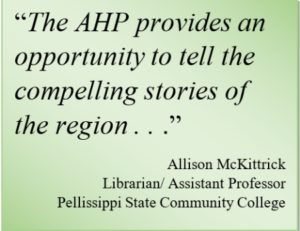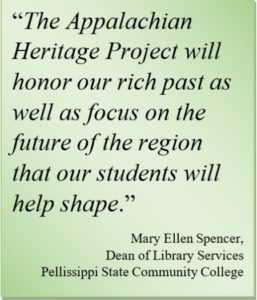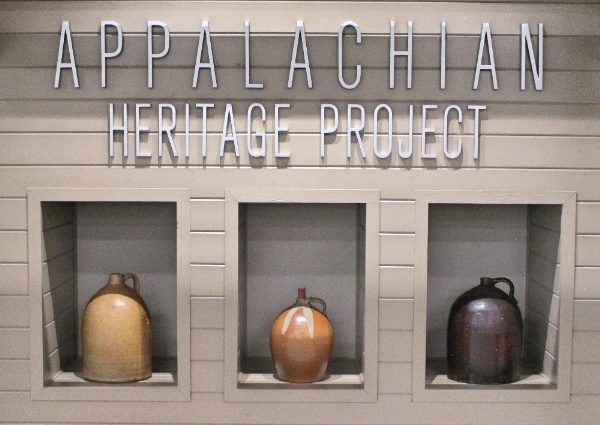An Appalachian Awakening is happening all around us. We peer through our emblematic windows – clear or murky – and see a new dawn’s vivid light peeking above the grey clouds that, to a great degree, were thrust upon us. Our eyes gaze upon lands and mountains where the footsteps of our ancestors are stamped, proud and defiant, inside the soil. Something flowered there, within that earth, that laid dormant for centuries. We can open our windows now. And, when we do, we must let loose our voices. We must venture out and tend to the fresh blooms. We must let it be known that we are filled with self-respect, ancestor awareness, and the acceptance of whatever past made a beautiful us: Appalachian Mountain people.
Great efforts are being made to ensure our voices are heard. These places shine like jewels across the mountains. One such gem just cut the opening ribbon less than a month ago. Appalachia Bare was invited to attend the grand opening of the Appalachian Heritage Project (AHP), located at the Strawberry Plains Campus of East Tennessee’s Pellissippi State Community College. We couldn’t be prouder to share our encounter of this wonderful place with our readers.
 The day was September 9, 2022, and the sun shone bright as a slight breeze moved through the air. We were warmly greeted by Associate Professor of English and Director of the Young Creative Writer’s Workshop, Patty Ireland. The Appalachian Heritage Project’s grand opening coincided with the 10-year anniversary celebration of Pellissippi’s Strawberry Plains Campus. The talented band Hardin Valley Thunder played the kind of bluegrass music that made a person want to sit there forever.
The day was September 9, 2022, and the sun shone bright as a slight breeze moved through the air. We were warmly greeted by Associate Professor of English and Director of the Young Creative Writer’s Workshop, Patty Ireland. The Appalachian Heritage Project’s grand opening coincided with the 10-year anniversary celebration of Pellissippi’s Strawberry Plains Campus. The talented band Hardin Valley Thunder played the kind of bluegrass music that made a person want to sit there forever.
After the celebration, Pellissippi’s Dean of Library Sciences, Mary Ellen Spencer, graciously awarded Appalachia Bare a special tour of the campus library and Appalachian Heritage Project. We stopped at the former library first. The room had limited space and, as such, lacked sufficient library services. We stopped at the entrance to the new library. An extraordinary piece of artwork crafted by Pellissippi’s welding students is situated above the library door. The metal and wood showcase Appalachia’s trees, hills, and valleys.
We opened the doors and entered a bright, spacious area (9000 sq. ft.), and the initial feeling was one of contemplative peace and calm. A number of smaller rooms hug the perimeter. We crossed the threshold and saw a remarkable wooden sculpture by Brian Melton entitled The Next Chapter is Yours. The piece is “a representational bas-relief sculpture, hand-carved using traditional methods. . .” An open book supports the likeness of people in the forefront of Appalachian Mountains and nature, seeming to signify that the past has been written; the present is being written; and our future will be written by young persons.
The idea for the Appalachian Heritage Project was first formed in 2017 by librarian Susan Martel, who “noted the local library staff’s love of all things Appalachian and their strong identification with the history and culture of the area and its people.” The campus secured a grant from the National Endowment for Humanities. This grant, along with donors and the Pellissippi State Foundation, boosted the campus toward their Appalachian dream.
The area was “designed by Community Tectonics and built by Evans-Ailey Construction.” Every inch of the library was meticulously planned, incorporating an overall theme of Appalachia’s natural world. Chairs have a simple, modern design employing two colors – a blue that symbolizes Appalachia’s baby blue skies and deep blue lakes, and a green that signifies our numerous tree species or grassy flora. Carpeted areas have patch-colors comprised of slate-grey, speckled brown, and muted green. The wood element is smooth throughout. The walls are designed in slight notches, hearkening back to old log cabins.
The eye is drawn to the corner of the room where a gorgeous hearth-like area, reminiscent of settler days, rests atop natural stone flooring that reminds one of our river rock and mountain slate. To the left of this rustic area, booths are positioned in a long row beside floor-to-ceiling windows. Images come to mind of bygone passenger trains (the difference, of course, being these are stationary and equipped with plugs and USB ports) or perhaps the inference is that we should travel forward together. Not only do the large windows provide natural light to the room, they also offer a visual reminder of nature.
The AHP offers another prominent feature. Appalachian artwork is displayed all around the place. On that particular day, Appalachia Bare noted quilt art, metal art, and pottery, including face jugs. For an added touch, authentic, colorful advertising posters are festooned across plain walls. Appalachian arts and crafts will be a sustained, rolling focus at the Project.
Those of us who were born here have a deep-rooted connection to the past that shapes our present. Acknowledging our past and present is the first step toward a grounded future. The physical features at the Appalachian Heritage Project unite history and present-day. All the details that embody each room in the library remind us that a forward path is meaningful and certain.
Our tour continued to the side rooms, where Pellissippi students will gather, study, and practice without affecting the library’s quiet. One room is designated a virtual room where students can compile and edit videos or power points, or simply play games to relieve stress. The conference room, enormous and adaptable, had tables, chairs, and a kitchenette. We gathered here to discuss our thoughts about the tour, a little about our Appalachian identities, and what the AHP has to offer.
 The Appalachian Heritage Project’s plan is already being implemented. In accordance with the seasons, the Project will offer a quarterly venue for Appalachian programming, exhibitions, speakers, hands-on learning, workshops, etc. The main objective is to “promote a better understanding of Appalachia.” One way to support this goal is to “expand partnerships in the region and enhance community outreach via exhibits, lectures and workshops.” Appalachia Bare is proud to partner with the Appalachian Heritage Project in this endeavor.
The Appalachian Heritage Project’s plan is already being implemented. In accordance with the seasons, the Project will offer a quarterly venue for Appalachian programming, exhibitions, speakers, hands-on learning, workshops, etc. The main objective is to “promote a better understanding of Appalachia.” One way to support this goal is to “expand partnerships in the region and enhance community outreach via exhibits, lectures and workshops.” Appalachia Bare is proud to partner with the Appalachian Heritage Project in this endeavor.
The last part of our tour brought us to a sizeable section of shelves housing books of everything Appalachia. Books about the Appalachian Mountains or by Appalachian authors jutted proudly near the shelves’ precipice. Across from these, a separate table was dedicated to the tenacious, accomplished Appalachian author, Charles Dodd White. From this vantage point, the whole room was in view again, and we recognized that all the ceiling lights are fashioned in circles with subdued brightness. What came to mind was that we had, quite literally, come full circle. Melton’s sculpture used a book as the foundation for the past, present, and future. Before us were books whose writers have told their own tale of Appalachia, good or bad, and ultimately beautiful. Their collective spirit is felt here, nudging and gently urging, calling young people to move forward and write our next chapter.
The Appalachian Heritage Project is open Monday – Thursday from 8:00 a.m. to 7:30 p.m., and Friday 8:00 a.m. to 4:00 p.m.
An upcoming event at Pellissippi’s Strawberry Plains Campus is the Young Creative Writer’s Workshop. The event is Saturday, November 5, 2022 from 9:00 a.m. to 4:00 p.m. and is free to the public. Workshops will feature fiction, poetry, songwriting, screenplay writing, and publication. The keynote speaker is Charles Dodd White. Enjoy these images from the last Workshop, along with information about this year’s event.
Images courtesy of Patty Ireland
Sources:
Appalachian Heritage Project
Appalachia Speaks: Discovering and Weaving Stories of Self and Place in Our Changing World
Appalachian Heritage Project opens on Pellissippi State’s Strawberry Plains Campus
Thank you to . . .
Strawberry Plains Dean Mike North
Patty Ireland
Mary Ellen Spencer
Allison McKittrick
**Images in article body by Delonda and Tom Anderson


























